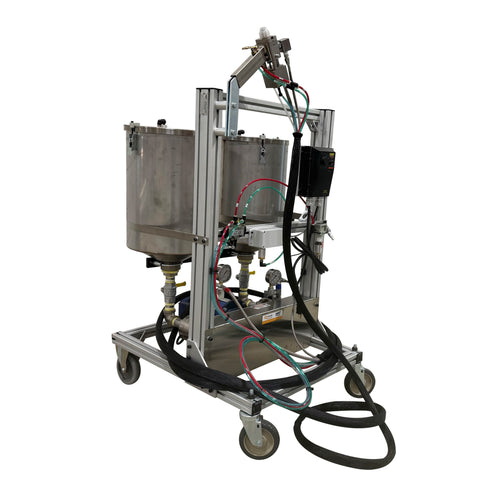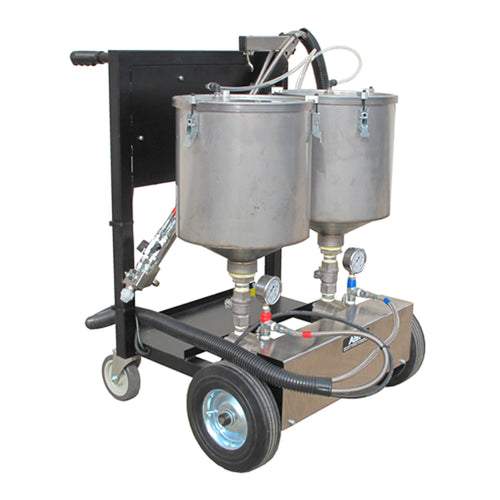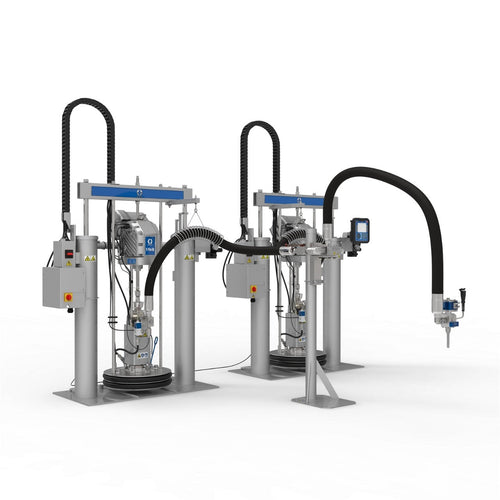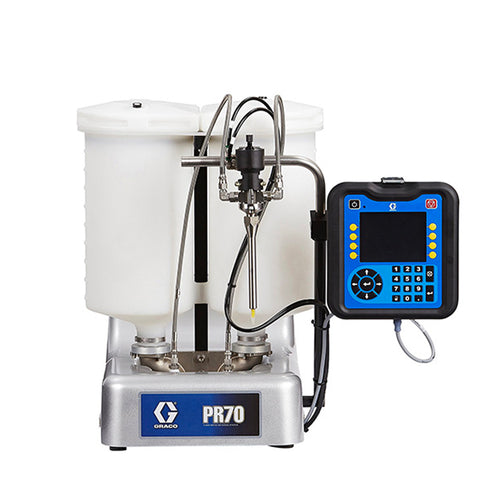More and more assemblers are turning to two-component adhesives for improved quality, productivity, and efficiency. Acrylics, epoxies, silicones, urethanes, and other adhesives have a number of performance properties that are often not available in single-component materials.
Two-part adhesives can offer faster handling and cure times. These characteristics are primarily controlled by chemistry, whereas single-component adhesives rely on some part of the environment to cure. In many cases, two-part adhesives also offer a longer shelf life, without adverse effects on performance qualities.
On top of this, two-part adhesives come in different formulations to meet a growing number of applications and can achieve properties that single-component materials cannot. Properties such as shrinkage, room-temperature cure, heat transfer ability, electrical insulation, and chemical compatibility are either not available or are not as desirable in a one-part adhesive.
That all being said, two-part adhesives require special equipment for dispensing to get the right results. Our experts take a closer look at metering and mixing dispensing, including its applications, equipment parts, and a few of our favorite meter mix dispensing systems.
What is Meter-Mix?
The term "meter-mix" refers to the process and the hardware required to accurately manage, blend, and dispense multi-part fluids in an automated fashion for bonding, filling, and encapsulating applications. Meter-mix dispensing is based on processing a two-part adhesive that is supplied as a base component and a hardener. When mixed in the proper volume and ratio, it causes a chemical chain reaction that initiates the curing process of the mixture. This process is most often used in electronics and industrial dispensing.
Depending on what is being mixed, it can be as little as a few minutes or up to days before the adhesive achieves its final cured state. Once a two-part adhesive is mixed, the end user should be aware of the specified "pot life" as this is the duration of time where the mixture can be used before the viscosity (or thickness of the liquid) increases beyond its usable state. In automated dispensing systems, once a mixture changes viscosity by even as little as 5-10%, this can have a negative effect on the consistency and repeatability of the process. Careful planning needs to take place to properly specify the correct metering and dispensing equipment.
Featured Meter Mix Dispensing Systems
With several years of experience in the adhesive dispensing industry, we are sharing a few of the top meter mix dispensing systems we love.
For accurate and efficient meter mix dispensing that doesn't take up too much space, this system is a great choice. It is especially great for bonding, potting, encapsulating, mold filling, and rapid prototyping. While a compact design, it can achieve a continuous flow up to .25 gpm and manage viscosities up to 2,000 cps. The system also features adjustable flow rates and ratios.
Another benchtop dispensing system to consider for your metering and mixing needs is the PR70. With a proven ratio accuracy of +/- 1%, this system is designed for precise and consistent dispensing for medium- to low- viscosity materials. It has an easy-to-use interface and fluid control module while still offering adjustable settings and dispensing parameters.
If you need to meter mix dispense adhesives in large quantities, a smaller system may not be the best choice. Instead, the GMP 075 is made for high-volume, industrial metering and mixing applications for non-filled materials. Common applications include potting, encapsulation, bonding, and molding. The system can be benchmounted or portable depending on your needs.
Meter-Mix Applications
There are numerous meter-mix applications depending on the material, equipment, and industry.
Two-part reactive adhesives, such as epoxies and acrylics, are gaining ground in the automotive industry, largely at the expense of solvent-borne systems. As more composite materials like door panels and interior trim are used to increase fuel economy and crash safety, adhesives are gaining more acceptance. Dual-component adhesives are usually less expensive and perform comparable to or better than mechanical fasteners or welding.
The electronics industry often uses multi-component adhesives as well. Most potting and encapsulating applications for vibration protection, environmental protection, or electrical isolation use two-part materials. Flip clip bonding and fiber optics are also on the cutting edge of multi-component adhesive technology.
Medical device manufacturers use multi-part adhesives to assemble monitoring devices, patient support surfaces, patient implants, and other products where clean, reliable bonding is required.
Another one of the most widely used applications of meter mixing technology is in the potting process where an enclosure with a circuit board is filled to a certain level to protect the electronics from moisture, dust, foreign objects, etc. This process can be used with small electronic sensors as well as to fill larger devices such as motor controller housings, LED video board assembles, or electric batteries. A potting process can be a simple benchtop configuration where an operator positions a housing underneath a nozzle and then steps on a foot pedal to initiate the dispense into a single location for a given amount of time or preset volume. In this case, the viscosity of the potting material is low enough to freely flow into all required areas.
More intricate two-component applications may require a multi-axis robot to drive a nozzle along a pre-programmed path to apply small beads or deposits of adhesive. Other precision applications may include staking of components to a circuit board or dispensing an encapsulant over exposed wire bonds. In these cases, the automation must be taken into consideration to apply adhesives at the proper flow rate and pattern to implement a successful process in production.
Other heavy users of two-part materials include cable manufacturers, filtration assemblers, and yacht builders.
Industries that utilize meter-mix equipment
- LED
- Industrial
- Military
- Aerospace
- Telecommunications
- Automotive
- Consumer Electronics
- Medical Devices
Metering and Mixing Technology Basics
Meter-mixing equipment allows easy, consistent measuring and mixing of material to achieve the right ratio. The application staff does not have to weigh or measure the materials. Instead, the machine ensures the correct ratio and mixing without the air entrapment experienced with hand mixing.
Reservoirs can range in size from syringes to supply systems dispensing liter-sized volumes. Metering pump technologies vary and must be chosen according to desired flow rate and the type of medium. The dispense valve and mixing device are typically combined into a single unit, but each play their own role in providing the proper dispense controls and blending of each fluid component.
Metering Pumps
Many types of pumps are available for accurately moving fluids, but there is no true "one-size-fits-all" technology that meets every capability requirement for all dispensing processes. There are many factors that come into play when outlining a meter-mix system such as desired flow rate, cure rate of the mixed composition, filler content and type (if any), viscosity, mix ratio, and process budget.
Gear
Fluid is fed into a chamber containing two gears that rotate inside a machined cavity. The gear teeth drive the fluid along the circumference of the chamber then force it to the pump outlet. One gear shaft is connected to a servo motor which provides precision control of the dispense rate. Pump accuracy depends on the machining tolerances between the gear teeth and pump walls. Gear pumps are available in different sizes and are typically rated on volume dispensed per revolution. An example fluid used with a gear pump system may be an unfilled silicone adhesive.
Rod/Piston
In meter mixing, rod displacement pumps consist of a cylinder with a single port on one end and a rod that can extend or retract within the chamber. The fluid port acts as the inlet or outlet depending on the state of operation. When the rod is retracted, a nearby outlet valve is closed while an inlet valve is opened to allow pressurized fluid to feed into the cylinder.
When ready to dispense, the inlet valve is closed and the outlet valve is opened. Then the rod extends to displace the fluid inside the chamber and feeds the desired amount and flow rate. High-precision units are configured with a linear servo drive to allow for a programmable feed rate. These are used for filling and gasketing applications. Basic units may offer a pneumatic drive to provide simple shot/filling capability but are not always suitable for prevision line dispensing. An example fluid used with a rod displacement system may be a high viscosity and highly abrasive thermal interface gap filler.
Progressive Cavity
Progressive cavity pumps use a rotor-stator combination where a helical rotor spins inside of a molded seal which contains a number of cavities. As the rotor spins, the fluid inside of each cavity gets pushed toward the outlet of the assembly. Due to the servo control on the motor and the tightly sealed assembly, the rate of rotation will directly impact the pump's output rate. For example, if the rotor RPM doubles, the flow rate will double as well.
By design, each cavity inside the stator will flex as the rotor spins to allow the fluid to advance forward with each rotation and then reseal. The constant rotation of the pump provides for continuous dispensing with no limitation on shot size. The flexible seal design allows for the use of fluids with some fillers without imposing high levels of shear which could change the fluid properties or grind up large filler particles. The progressive pump design allows for processing of low to medium/high-viscosity fluids without concern of dripping or leaking. An example fluid for a progressive cavity system may be an acrylic or urethane adhesive with glass spacer beads throughout.
Mixers
Mixers can be either static or dynamic. Static mixers have no moving parts. They contain fixed, geometrically shaped elements that act as flow-splitting and shear-energy-creating devices for the materials that travel through them. Static mixers are usually either plastic or metal. They work well if the ratio and viscosity ranges of the two materials to be mixed are not too wide.
Static mixers serve as inline mixers - the components to be mixed are pumped through the mixer and emerge out the end completely mixed. They can be used with both two-component machines and cartridge applications.
Once the fluids are delivered at the proper ratio and rate, the two components must be mixed to initiate the cure process. Two-component adhesives are typically mixed just prior to the application point using a valve with on/off control coupled with a disposable mixing element. There are a range of valves available with different flow rates but generally speaking, there are two methods: static or dynamic mixing.
A static mixing valve utilizes a static mix tube attached to the outlet of the fluid body to channel the two fluid components along a number of helical or stepped elements molded together in an alternating pattern and fixed inside of a plastic tube. The elements are aligned in such a way that creates a flow path which forces the two components together to continuously mix as the fluid travels through the tube.
Many static mixers are available. The correct mixer is chosen based on the flow rate of the system, the viscosity of the fluid, and the pot life of the mixture. Choosing a mixer with to few elements will result in improperly mixed materials and poor curing and/or adhesion. Choosing a mixer that has too many elements may cause premature curing of the adhesive inside the mixer which leads to inconsistent dispensing. Static mixing works well for fluids with A and B components that are relatively close in viscosity or require nominal mix ratios such as 1:1 up to even 10:1 in some cases. Some examples might be silicone or epoxy-based resins.
In dynamic mixers, materials are rotated with an auger or paddle within a mixing chamber by means of rotary air, electric, or hydraulic motors. In dynamic mixing, the material passes into a chamber with a rotating element. Higher mixing and shear is created, providing better mixing.
Most dynamic mixers must be thoroughly cleaned after use, which takes time and exposes workers to hazardous waste. Typically, these mechanical mixers require solvent flush of the chamber. However, a hybrid dispense head is available that combines dynamic mixing with solvent-free mix chambers.
A dynamic mixing valve utilizes a disposable paddle or similar static-type mixer that can spin with the flow path to blend the 2 components as they travel through the mixing chamber.
The number and type of dynamic mixing elements may be limited but the mixing valve will have a setting that allows for choosing the rotation speed of the mixer to achieve the correct mix. Too slow of a mixer speed can result in improperly mixed material and poor curing and/or adhesion. Too fast of a speed can lead to premature curing inside the mixing chamber which leads to inconsistent dispensing. Dynamic mixing systems provide higher levels of shear on fluids than static systems. This allows for the processing of fluids with A and B components that may have a wide viscosity delta and/or wide mix ratio, such as a urethane-based adhesive, in some cases up to 100:1.
Let Us Assist You
While meter mix dispensing may seem overwhelming, understanding the basics of the metering technologies available can help you choose an appropriate meter mixing system for your needs.
At Dispensing.com, we carry a large collection of meter mix dispense equipment for various applications. If you need help finding a machine that meets all of your needs, our engineers can also configure the equipment according to your specifications. Contact us to get started.













